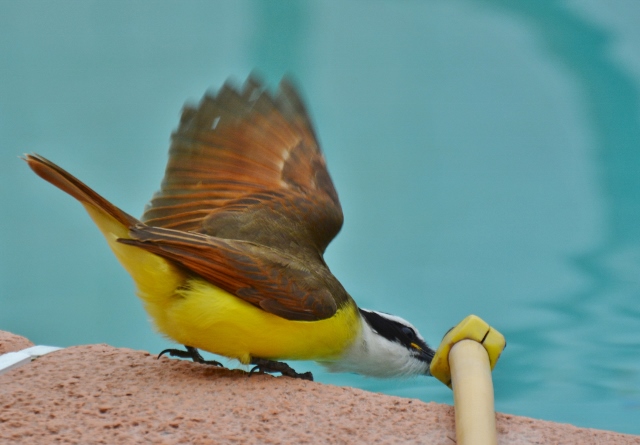By Anita Westervelt, Texas Master Naturalist

Many are familiar with the startlingly shrill shriek of the great kiskadee, but many don’t realize what a rare treat it is to have this bird in North America.
The Rio Grande Valley is the great kiskadee’s northern most range where it is a permanent resident. Another not so well-known fact is that it is a flycatcher, a rather large one at that, measuring 10 inches in length from tip of bill to tip of tail.
In the Valley, great kiskadees live typically near water along the edges of our unique thorn-scrub, river, mesquite and cactus forests. They also are common near resacas, irrigation canals, parks, fairway ponds and residential neighborhoods.
It’s relatively easy to get a closer look at these raucous, entertaining and flashy vibrant-yellow- bellied birds. They are omnivorous feeders and can be enticed to feeders with fruit, like bananas, during the winter when insects aren’t as prevalent.
They also like the ripe red fruit of Turk’s cap (Malvaviscus drummondii), a native plant that will grow in partial shade. Plant the shrub around the base of a tree where it can support itself along the tree branches. Turk’s cap’s red conical flowers also are a favorite of hummingbirds and butterflies.
As omnivores, great kiskadees feed mostly on large insects, beetles, millipedes, wasps, grasshoppers, bees and moths. They catch insects in flight. They will pluck lizards from tree trunks and eat mice and baby birds.
Near water, they perch where they can spot prey, then dive into the water to catch small fish, frogs and tadpoles.
They also will hop around shrubs eating berries, small fruits and some seeds. They’ve been caught frequently stealing dog and cat food out of pet dishes, and skimming residential swimming pools.
Although aggressively territorial during breeding season, which begins in March, great kiskadees often join similar foraging flocks of green jays and Altamira orioles in Texas — two other permanent resident species that are at their northern most range.
The versatile and colorful great kiskadee hunts like a flycatcher, fishes like a kingfisher and forages like a jay, according to description at www.allaboutbirds.org.
